Common menu bar links
2006
Archived Content
Information identified as archived is provided for reference, research or recordkeeping purposes. It is not subject to the Government of Canada Web Standards and has not been altered or updated since it was archived. Please "contact us" to request a format other than those available.
Analysis
After-tax income increased for the third consecutive year
The 2006 median after-tax income for Canadian families with two or more people rose 2.1% 1 to $58,300, after adjusting for inflation, according to new data from the Survey of Labour and Income Dynamics.
Market income and government transfers contributed to the increase in after-tax income. This expansion is consistent with the strong economic growth, as measured by the real gross domestic product, which rose 2.7% in 2006. The expansion was also observed by the Labour Force Survey which saw employment rise by 2.0% while unemployment fell to an all-time 30-year low of 6.3%.
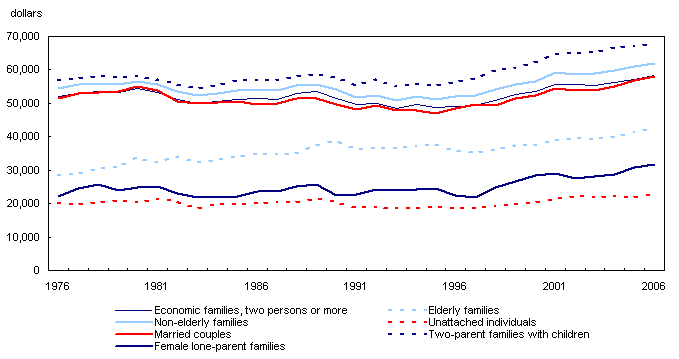
Both senior and non-senior families shared this increase in median after-tax income. Senior families (whose main income earner was aged 65 or over) saw a 2.9% increase in their median after-tax income between 2005 and 2006. Families whose main income earner was under 65 years of age received median after-tax income of $62,000 in 2006, which was up 1.8%. Since 1996, which was the end of the last recession, senior and non-senior families experienced an 18% and 19% increase in their median after-tax income, after adjusting for inflation.
After being relatively stable since 2002, median after-tax income of unattached individuals increased by 4.6% to $22,800 in 2006 from $21,800 in 2005. Between 1996 and 2006, their median after-tax income had improved by 23%.
Seniors (aged 65 or over) living on their own had a median after-tax income of $20,800 in 2006, representing an increase of 4.0% from 2005. This increasing trend has continued since 1996 where their median after-tax income was at $18,200, representing a 14.3% increase over the 1996 to 2006 period.
Concerning unattached individuals who were under 65 years of age, their median after-tax income rose 4.7% to $24,600 in 2006. Similar to their senior counterparts, the median after-tax income followed an upward trend since 1996 with a value of $18,900, representing an increase of 30% since 1996.
Provincial family income: Albertan families had highest median income for the third consecutive year
For the third consecutive year, Albertan families with two or more people had the highest median after-tax income with $70,500, followed by Ontario at $62,400 and British Columbia at $60,300.
The development of the oilsands in Alberta continued to have large economic impacts 2 not only for Albertans, but also for its neighbouring province, Saskatchewan, which were the only two provinces for which the change was statistically significant. Albertan families experienced a 7.0% increase in their median after-tax income while Saskatchewan families saw an increase of 6.3% compared to the previous year.
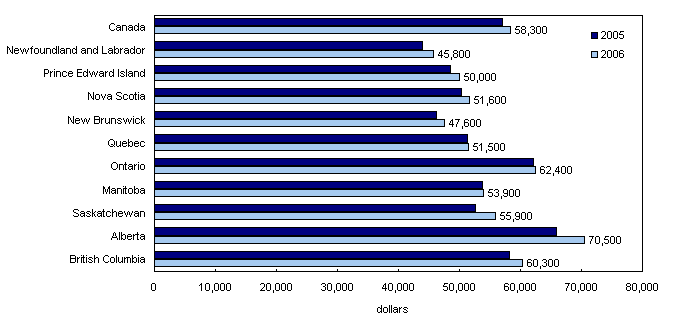
While the increases of family median after-tax income were observed in the west at the provincial level, these increases varied across families. The increase in median after-tax income among the non-senior families was seen not only in Saskatchewan ($60,200) and Alberta ($75,300), but also in Newfoundland and Labrador ($49,800) and New Brunswick ($51,100). The median after-tax income of non-senior families residing in the other six provinces remained stable between 2005 and 2006.
Senior families in Quebec ($35,700) experienced an increase in their median after-tax income in 2006, while it remained virtually unchanged for the rest of the senior families across Canada.
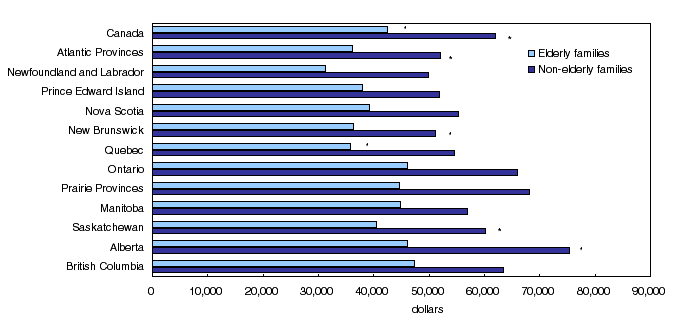
Market income for working-aged families improved
A 1.8% increase of median market income for working-aged families (whose main income earner was under 65 years of age) was observed in 2006 (from $65,600 to $66,800). Market income is the sum of earnings from employment, investment income and private retirement income.
Although senior families’ median market income remained virtually unchanged at $23,300 in 2006, there has been a long term increase in their market income, where they saw a 40% increase during the 1996 and 2006 period, after adjusting for inflation. This reflects, in part, growth in employment during this period among seniors. According to the Labour Force Survey, the employment rate among persons aged 65 and over was 7.9% in 2006, which was 2.0 percentage-points higher than the rate in 1996 (5.9%).
The level of market income continues to vary by family type. Median market income of two parent families with children was $74,900; couples without children received $65,400; while other non-senior families received $51,700.
Median market income of female lone-parent families, at $23,100, remained virtually unchanged from 2005. Nevertheless, this group saw a significant increase in their market income compared to their 30-year low of $8,700 received in 1996. Much of the gain experienced during the 1996 to 2006 period reflects higher earnings and a larger proportion of working mothers.
Unattached seniors saw an increase of $1,000 in median market income between 2005 ($5,900) and 2006 ($6,900) while unattached non-senior individuals did not experience a significant change in their median market income.
Market income improvements are not observed for all family types because the composition of pre-tax income by income source varies, especially between non-senior and senior families. Among non-senior families, market income made up the largest share of pre-tax income. For every $100 of total income, non-senior families received $93 in market income, and the remaining $7 from government transfers.
In comparison, senior families relied less on market income, receiving almost six times as much of their total income from government transfers compared to non-seniors families. For every $100 of total income in 2006, they received $39 from government transfers and only $61 from market income.
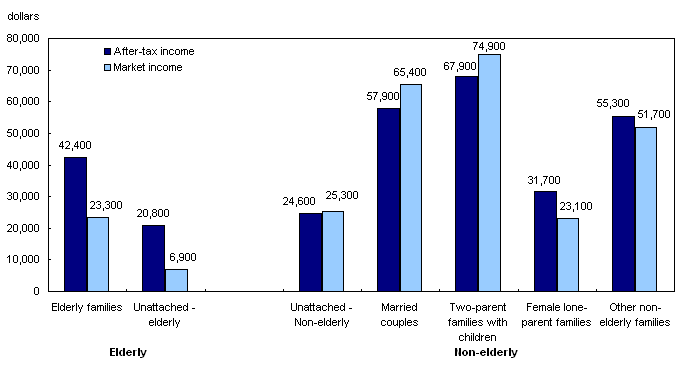
Median market income up in the three most western provinces for working-aged families
At the provincial level, working-aged families residing in Saskatchewan had an increase in median market income which rose by 9.8% to $65,900 in 2006. Albertan working-aged families had the highest median market income ($83,800) which was 5.8% higher than in 2005. British Columbian working-aged families experienced a 5.7% increase in median market income between 2005 ($64,800) and 2006 ($68,500). Working-aged families in all other provinces saw virtually no change in their family median market income.
Market income is closely tied to labour market conditions. According to the Labour Force Survey, employment in British Columbia grew 3.1% in 2006. This matched Alberta’s torrid growth over the last two years. By late 2006, unemployment in BC had almost fallen to 4.0%; a level that only Alberta and Saskatchewan have successfully broken through.
Among senior families, only those residing in British Columbia saw a significant increase in their median market income. It increased by 16% to $30,600 in 2006. There were no significant improvements or deteriorations of median market income across the ten provinces for seniors living on their own.
Increase in government transfers, while no change in taxes
Canadian families of two persons or more as well as unattached individuals saw a rise in government transfers, while their median taxes paid remained virtually unchanged from 2005. Families reported a median government transfer of $4,500 in 2006 (up $500 from 2005), while they paid a median level of $9,000 in taxes which remained the same as the previous year. Among the unattached individuals, their median government transfers increased by $100 from the previous year to $600 and they paid median taxes of $2,100, virtually unchanged from 2005.
In 2006, families whose main income earner was under 65 years of age reported a median government transfer of $2,800, up $400 from 2005. Government transfers to senior families remained virtually unchanged at $22,600.
There were changes to existing benefit programs such as the Canadian Child Tax Benefit. For example, the Universal Child Care Benefit for children under 6 years of age was a new program that began part way through 2006, providing families $100 per month for each child under 6. Two-parent families with children saw an increase in the amount of government transfers between 2005 and 2006 in part because of the introduction of the Universal Child Care Benefit. Their median government transfers were $3,300 which was $500 more than the previous year.
Additionally, new federal and provincial benefits in 2006 included one-time transfers such as the Federal Energy Cost Benefit which provided lower income families with children or seniors with a non-taxable benefit which aimed to deal with high energy costs. There was also the Alberta resource rebate where every resident in Alberta who filed their personal income tax in Alberta for 2004 received a $400 resource rebate in January 2006. This was motivated by the results of high resource energy revenues.
Those changes in government programs led to increases in the proportion of families receiving government transfers – about 4.5% for families of two or more persons and 5.9% for unattached individuals in 2006. These are the biggest year-to-year percentage increases in over a decade. Approximately 7.9 million families (or 88%) and 3.8 million unattached individuals (or 83%) received government transfers in 2006.
The aggregate amount of government transfers distributed to families increased by 5.9%. The Survey of Labour and Income Dynamics estimates suggested that $78.2 billion was transferred to families in 2006 compared to $73.8 billion in 2005. This compares to a 2.8% increase in the aggregate amount distributed to persons living alone, from $24.7 billion in 2005 to $25.3 billion in 2006.
The distribution of these transfers varies among different family types. In fact, for non-senior families of two or more persons, the shares of government transfers from programs such as employment insurance (EI) benefits, child tax benefits (CTB), and Canada Pension Plan (CPP)/ Quebec Pension Plan (QPP) benefits were 25%, 23% and 17% respectively in 2006. The other 35% of government transfers for this group went to programs such as workers compensation, Goods and Services Tax (GST) and Harmonized Sales Tax (HST) credits, Provincial and territorial tax credits, Old Age Security and Guaranteed Income Supplement and Spouse's Allowance (OAS/GIS/SPA), and Social assistance.
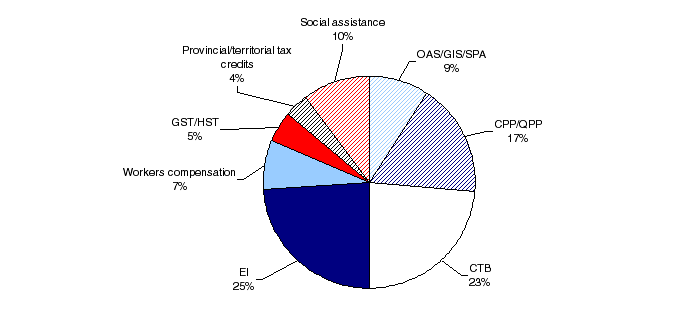
A large proportion of government transfers to senior families were from OAS/GIS/SPA (48%) and CPP/QPP (43%), while the other 9% were allocated to other transfer programs listed above.
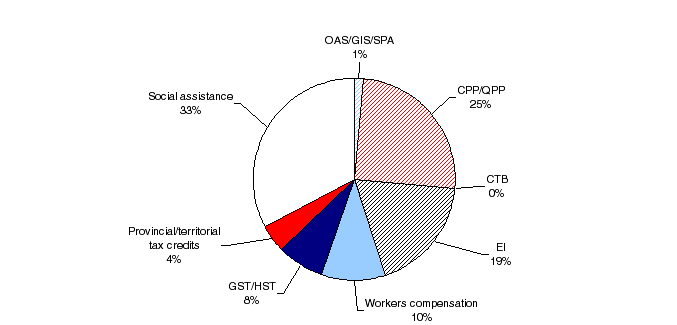
For those living alone and under 65 years of age, about one-third (33%) of their government transfers were from social assistance, 25% were from CPP/QPP, 19% were from EI benefits and 10% from workers compensation. The remaining 13% was allocated to the other transfer programs listed.
Similar to the senior families, majority of the government transfers to those seniors living alone were distributed to OAS/GIS/SPA (52%) and CPP/QPP (42%), while the other 7% were allocated to other transfer programs listed.
The one-time Federal Energy Cost Benefit, which provided lower income families with children or seniors with a non-taxable benefit, had a significant impact on transfers coming from the federal government. Approximately 1.9 million families received the Federal Energy Cost Benefit which aggregated to about $426 million in 2006. About 603,000 unattached Canadians received these in 2006 with an aggregate value of $75 million.
Changes to the Child Tax Benefit program, such as the Universal Child Care Benefit, lead to an augmentation of 3.6% in the number of families receiving these transfers in 2006 as compared to 2005. The aggregate amount of CTB transferred to the 3.6 million recipient families was about $11.3 billion in 2006, which was 9.0% higher than the previous year.
Median government transfers for families up in three of ten provinces
Median government transfers increased in New Brunswick, Ontario and Alberta for families in 2006. Alberta median government transfers doubled to $3,000 in 2006 from $1,500 in 2005. This large increase was generated by a one-time Energy Rebate program, motivated by this province’s high resource energy revenues. This rebate was given to about 910,000 families which summed to an approximate $1.1 billion.
Among unattached individuals, only those living in Alberta saw an increase in their median government transfers between 2005 and 2006, increasing from $400 to $600. Again, this was in large part due to the one-time Alberta Energy Rebate where approximately 454,000 unattached individuals received the rebate which aggregated to about $182 million in 2006.
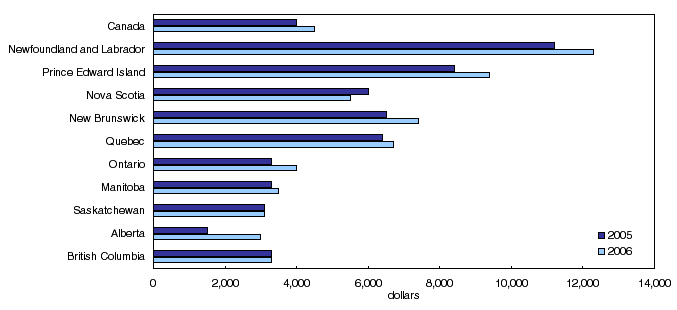
Tax and transfer system continues to reduce income inequality
Government transfers and federal-provincial income tax systems are two mechanisms used by the government to redistribute income in order to reduce income inequality. One way of illustrating the redistributive nature is to look at the ratio of average income earned by the top quintile compared to the average income earned by the lowest income quintile among various income concepts (Chart 8). This pertains to market income which reflects labour market conditions, total income (or pre-tax) reflects effects of government transfers and after-tax income takes into account the two effects.
For the purpose of analysis, families were equally divided into five groups according to their after-tax income, with each group representing 20% of all families. These groups are called “quintiles”.
In 2006, the average market income for families in the highest quintile was 12.3 times higher than those in the lowest quintile. However, government transfers reduced the ratio of the top to bottom quintile to 6.7 times higher. After taxes, the average income for families in the highest quintile was 5.4 times higher than their counterparts in the lowest quintile.
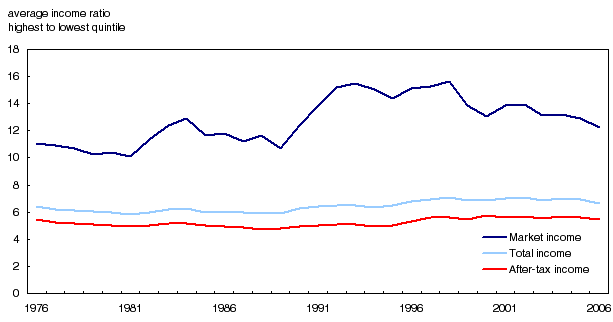
Incomes across the distribution improved in 2006, except for those in the highest quintile
Since the end of the last recession in 1996, average after-tax income for families has been on the rise since. When the population of families is broken down each year into five equal-sized groups or “quintiles”, from lowest after-tax income to highest after-tax income, it can be seen that all five quintiles shared, to some extent, the increases in after-tax income over the last decade. However, this increase was not equally distributed among the quintiles.
The 20% of families with the lowest family after-tax income saw an increase in their average after-tax income of 5.6% between 2005 and 2006. Their average after-tax income was $24,600 in 2006, up from $23,300 in 2005 and up from $19,800 in 1996 (or 24%).
Families in quintile 2 receive almost twice as much in average after-tax income as those in quintile 1. This has been the case since 1976. Average after-tax income for this group was $42,600, up 2.4% from 2005 and up 21% from 1996.
Families in 2006 in quintiles 3 and 4 also benefited from positive economic conditions. Their average after-tax income increased by 2.3% and 1.8% between 2005 and 2006 and increased 19% and 20% respectively since 1996.
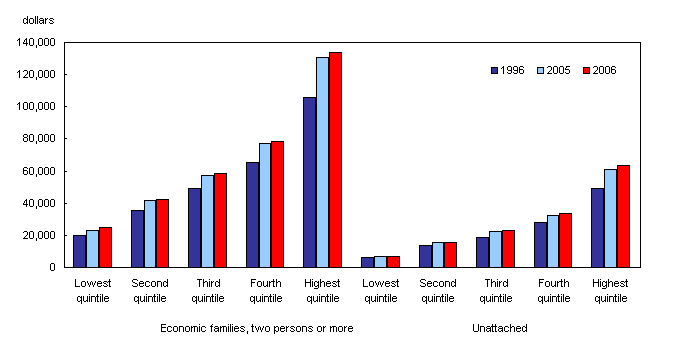
The 20% of families with the highest family after-tax income did not experience a significant increase in their average after-tax income between 2005 ($130,700) and 2006 ($133,900). However, their average after-tax income increased by 27%, the fastest growth over the 1996 to 2006 period.
Unattached individuals in the lowest and highest quintiles did not experience a significant increase in their average after-tax income while those in the other three quintiles benefited from positive economic conditions in 2006. Average after-tax income among unattached individuals in quintile 2 increased by 2.6% between 2005 and 2006. Those in the middle of the pack saw a 4.1% increase in their average after-tax income to $23,000 in 2006 from $22,100 in 2005. Average after-tax income among those in quintile 4 increased by 3.1% between 2006 and the previous year.
Those living on their own also profited from the upbeat economic conditions over the 1996 to 2006 period. Those in the third quintile and the highest quintile enjoyed fairly substantial increases, 23% and 29% respectively, while those in the first, second and fourth quintiles realised more modest gains at 9.4%, 15% and 19% respectively.
Inequality gap continues to widen since the last recession
The inequality gap is the dollar difference between the average after-tax income of the highest and lowest quintiles. Although the inequality gap between 2005 and 2006 remained virtually unchanged, this difference increased by 27% between 1996 and 2006 for families with two or more persons. Among the unattached, the gap increased by 32% over the 1996 and 2006 period.
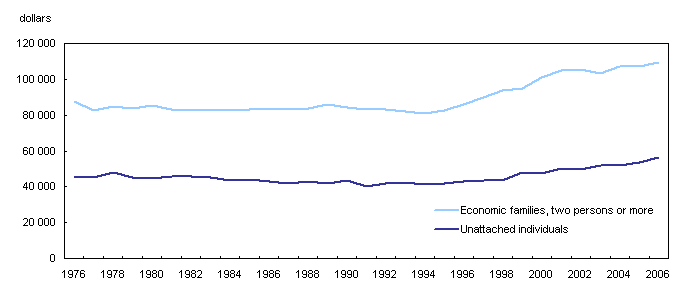
Stable low income rates, despite decrease in family low income gap
Despite the fact that there was an increase in after-tax income for families in the lowest income quintile, the family low income rate remained stable between 2005 and 2006. An estimated 633,000 Canadian families were below the low income cut-off (LICO) after taxes, representing 7.0% of all families, a proportion unchanged from 2005. However, families in low income needed on average $7,000 to climb above the low income cut-off, an improvement compared to the 2005 average of $8,000.
Statistics Canada’s low income rate measures the percentage of unattached individuals and families below the low income cutoff (LICO). The LICO is the after-tax income below which most Canadians spend at least 20 percentage-points more than the average to food, shelter and clothing.
In 2006, the low income rate of persons living alone also remained stable at 29%. On average these 1.4 million singles faced a low income gap of $6,500 a similar level to last year’s figure.
The low income rate of families residing in Alberta decreased to 4.0% in 2006 from 2005 while there were no changes in the low income rates in the other provinces. Among those living alone, only those residing in Manitoba experienced a drop in the low income rate to 26% from 31% of the previous year.
Low income varies across family types
Among non-senior families the incidence of low income was virtually unchanged at 7.9% in 2006. The incidence varied from 8.9% in 1980, up to 13.5% in 1996 and down again to the current level.
Senior families – family type with the lowest incidence of low income in 2006 – saw their low income rate remain relatively stable at around 2.3%. Despite the recent stability of low income rate among this group, the low income rates of senior families have constantly been decreasing from 7.6% in 1980 to its current rate in 2006.
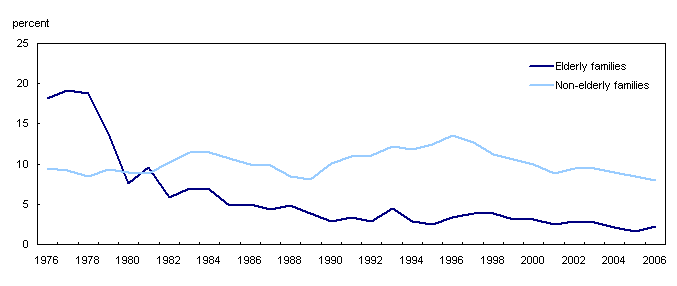
Senior families saw a sudden decrease in their low income rate during the late seventies; this was mainly associated with modifications to the CPP/QPP program. Since the early eighties, senior families have always shown lower incidence of low income compared to their non-senior counterparts.
The low income rate for female lone-parent families remained stable at 28% in 2006, putting an end to a three-year downward trend in their incidence of low income. This represents just over half of the 1996 peak of 53%.
Female lone-parent families have always shown a high incidence of low income. In fact, in 2006 the incidence for female lone-parent families is more than four times as high as that of two-parent families with children.
Even though the incidence of low income remained the same in 2006 from the previous year for two-parent families with children, these 195,000 families in low income saw their low income gap decrease from $9,300 in 2005 to $7,300 in 2006.
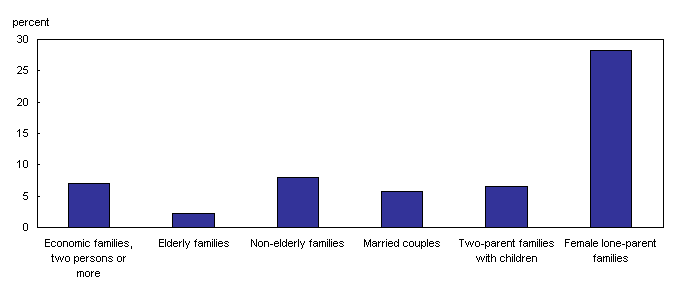
Of the 2 million families and singles in low income, more than two-thirds (68%) were unattached individuals in 2006. In fact, 29% of unattached individuals lived below the low income threshold.
In 2006, the low income rate for non-seniors living alone was just over two times higher than that of unattached seniors, 34% compared to 16%.
The situation was reversed 30 years ago when the low income rate of unattached seniors was over two times higher than that of unattached non-seniors. While the incidence of low income for unattached seniors decreased from 65% in 1976 to 16% in 2006, the rate for non-senior varied from 31% in 1976 to 44% in 1997 before decreasing to 34% in 2006.
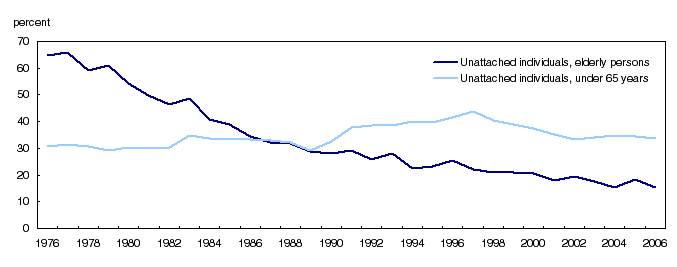
Persons in low income
In 2006, 3.4 million Canadians lived in a situation of low income, representing 10.5% of the population, percentage unchanged from 2005.
About 760,000 children under 18 years of age lived in low income families in 2006, a number unchanged from 2005, but down from the 1.3 million in 1996. The proportion of children in low income families fell from its peak of 18.5% in 1996 to about 11.3% in 2006.
In 2006, approximately 307,000 of these children in low income lived in female lone-parent families, representing 40% of all children in low income. In fact 32% of children living in female lone-parent families were in low income situation in 2006. This number is down from the peak of 1996, where 56% of children in female lone-parent families were in a low income situation. In comparison, the proportion of children in low income living in two-parent families decreased from 12.4% in 1996 to 7.7% in 2006.
Nearly 16% of unattached seniors lived below Statistics Canada’s low income cut-off in 2006. The low income rate among unattached seniors follows a downward trend which began in the early 1980s, while low income rates for seniors living in families remained relatively stable over the years.
Seniors living on their own face a much different reality then their senior counterparts that live in families. Seniors living alone experienced a low income rate more than 11 times higher than seniors living in families in 2006 (16% versus 1.4%).
Every three in four seniors living on their own and experiencing low income were female in 2006. Among those 179,000 seniors, approximately 134,000 were females while 45,000 were males.


